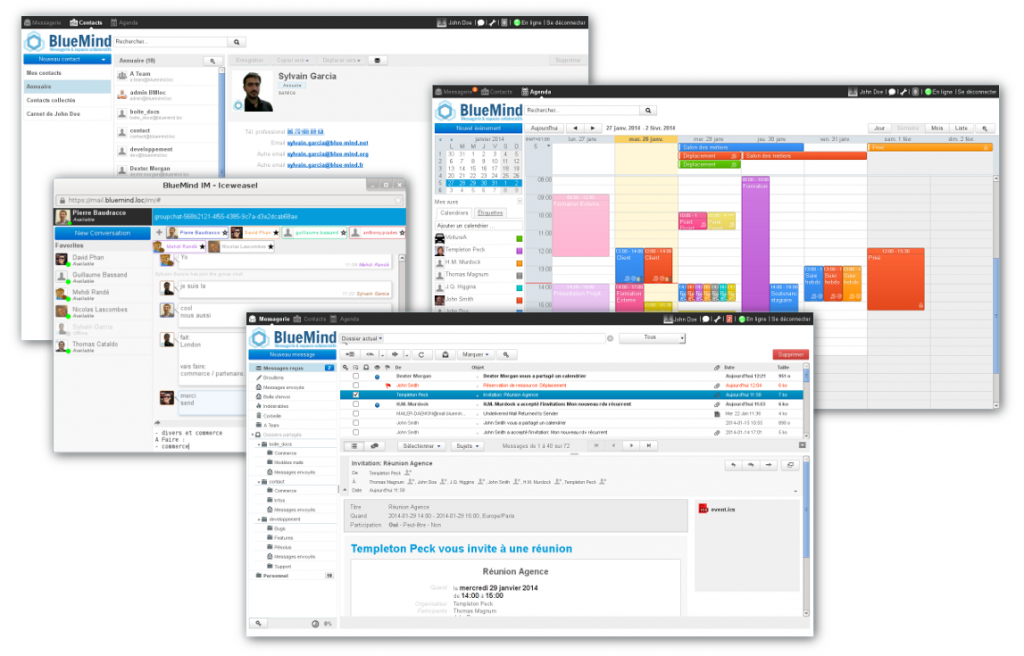“A software publisher’s job is to build, brick by brick. Staying on course. Not letting yourself get side-tracked from your objectives!” Pierre Baudracco, CEO of BlueMind recently said at a conference. BlueMind has been designed with one very specific goal in mind: to become an open, sovereign alternative for businesses’ most critical tool – email. To do this, many challenges must be tackled, many bricks must be laid, but more importantly, you must be unwavering, stay on course and persevere.
The approach needed to build a full-fledged solution is worlds apart from the typical image of “tech” companies we get through the likes of CES Las Vegas, unicorns or industry buzzwords. Our strategy is clear and long term. We’re running a marathon, not a sprint.
Throughout its development process, BlueMind has been building, brick by brick, the solution that was set to become an alternative to the market’s giants. Let’s take a look back…
.
BlueMind 3: paving the way for collaborative work
BlueMind 3 was released on 14 February 2014 — Valentine’s day. This was a symbolic date indeed as this new version of our open-source email solution had required a lot of love, but most significantly, a lot of work.
Just before it, versions 1 and 2 represented, as Pierre Baudracco said in an interview at the time: “a major step for the BlueMind team, for many clients who were waiting for this version to move to production use, and for the collaborative email market as a whole as it ushered in a technological and functional leap through an open-source solution”. This breakthrough was acknowledged upon its release, in 2012, with an OWF Innovation Award.
Back then, BlueMind’s vision already was extremely clear: being a sound and viable alternative to the market’s giants (mostly US-based). This implied that BlueMind’s development goals must never stray from one idea: always keep user habits in mind. And on that path, it quickly became obvious that a lock called Outlook was standing in our way. But that’s another story.

The story of BlueMind 3.0 is about a giant leap in the collaborative aspects of the solution:
- Instant messaging
- Full-text webmail search engine
- Tags
- CalDAV support and macOS calendar syncing
- Single Sign-On
- Improved filter management
In parallel with these front-end features, considerable effort went into consolidating the software architecture and keeping the BlueMind Core state of the art. Just as we showed here about version 4, a publisher’s work is never done.
.
BlueMind 3.5: adapting the software architecture to lay the groundwork for the future
To ensure BlueMind’s compatibility with all uses, its architecture had to be capable of complying with all types of clients.
Released in November 2016, version 3.5 came with the implementation of several major development projects:
- A scalable architecture capable of meeting the demands of organisations with tens to hundreds of thousands of users,
- Optimum capabilities combined with architecture evolutions to ensure high performance while keeping resource consumption under control,
- Extension points to facilitate plugin-based improvements to the BlueMind solution, as opposed to complex development work,
- All features exposed via an API – making all BlueMind application actions API-based.
BlueMind 3.5 has improved elasticity – this means it can accommodate growing numbers of users, from a few dozens to hundreds of thousands. Load and service balancing is also improved. The data model has been partially denormalised to enable some data distribution and autonomy, which is better suited to Cloud-based solutions.
If you’d like to find out more about BlueMind Core evolutions, we recommend this article. And there’s more about continuous integration and the BlueMind production factory here (and a video here).

But BlueMind 3.5 isn’t just about back-end (albeit essential) infrastructure work. It’s also a leap forward feature-wise: optimised Mail and Calendar applications, a new Tasks application, improved syncing and finer rights management for admins.
The most noteworthy features in version 3.5 include:
- Linked attachments, which does away with the impact of emailing large files by allowing users to detach them and send them as hyperlinks,
- Multi-calendars, i.e. enabling users to create as many personal calendars as they wish and better manage shared events,
- A Tasks application with a dedicated interface synced with the Calendar,
- Enhanced roles and admin rights management.
All the details about BlueMind 3.5 are available here.
The groundwork has been laid. BlueMind 3.5 is a robust, proven solution that has been deployed for hundreds of clients of all sizes. We offer the best support for Thunderbird, a major email client. BlueMind remedies Thunderbird’s inherent faults and natively turns it into a collaborative champion. Our webmail is growing strong, becoming more user-friendly and easier to access. The path to a sovereign, open solution has never been so clear. And yet, one cloud remains on the horizon…
An end-of-game boss that our quest for an alternative solution will inevitably force us to face: Outlook – unadulterated, without alterations.
.
BlueMind 4: the revolution
Outlook is ubiquitous. It’s the most popular email client for business. Email being the tool people use the most on a daily basis, far ahead of any other, it is strongly conditioned by user habits.
And for many people, habit equals Outlook.
Like other email solutions, BlueMind already provided an Outlook connector as an extension. But such extensions come with two major caveats: they make deployment and management more complex and, more importantly, they alter Outlook’s typical behaviour and interfaces, making it less reliable, less functional, and ultimately deviate it from what people are used to!
To achieve our objective to become a sound, sovereign alternative to the market’s giants, we had to provide NATIVE compatibility with users’ favourite email client, without alterations.
Easier said than done.
What we’d already accomplished with Thunderbird or macOS simply couldn’t be replicated here. Outlook is designed to be Microsoft Exchange’s client. Outlook communicates with Exchange servers via a series of protocols called MAPIs – which are completely different from standard protocols (POP and IMAP which only handle the email part) – and let it sync all Outlook data (Calendars, Contacts, Tasks, Notes, Free/Busy information, etc.). The data MAPI (and therefore Outlook) handles is MAPI objects whose characteristics are poles apart from typical emails, events, contacts, etc. Replacing Exchange therefore requires modifying the BlueMind infrastructure for it to understand and handle MAPI objects and implement the MAPI stack on the server side to communicate with Outlook just like the Microsoft server does.

“The technical challenge was immense”, comments Thomas Cataldo, BlueMind’s Technical Director, “implementing all the MAPI layers on the server side has taken several developers over five years’ work”. Watch Thomas’s conference to hear all about the work BlueMind has carried out.
With BlueMind v4, we finally have a sovereign solution that’s compatible with all uses, even though our work is far from done. Like with any new version release, it’s been a reality check. What works in vitro sometimes comes with its fair share of surprises (and new cases) in vivo. The year 2020 has been – and still is – a year of finishing touches and adjustments to “live production situations”. Our teams are still hard at work consolidating and adapting BlueMind v4 and finally overseeing the deployment of Outlook’s native compatibility!
And, beyond the Outlook revolution, it is worth noting that BlueMind v4 also comes with an enterprise signature tool, improved resource management (in particular videoconferencing), easy and comprehensive monitoring of the installation… It’s all laid out in our documentation.
.
What now ?
Our software publishing workshop still has plenty of ongoing projects in store. They are the essence of what we do: technical and software architecture evolutions, staying at the state of the art, optimised performance, technical debt resolution, new tools and interfaces, improvements to our apps and our ecosystem… There’s always lots of work in the pipeline.
BlueMind’s next big move is an overhaul of the web interface, starting with a new webmail. This Herculean project has been keeping a dedicated team of developers, graphic designers and UX designers busy for almost two years. Our goal: to offer a modern, light and feature-rich interface especially designed for the web. Once again, this final “product” encompasses many other projects: offline mode, webservice-based operation (IMAP discontinued), management of webmail/thick client transitions, etc.

BlueMind’s new webmail beta version will be available by the end of this year.
As for version 3, it will no longer be supported as of 14/02/2021.





